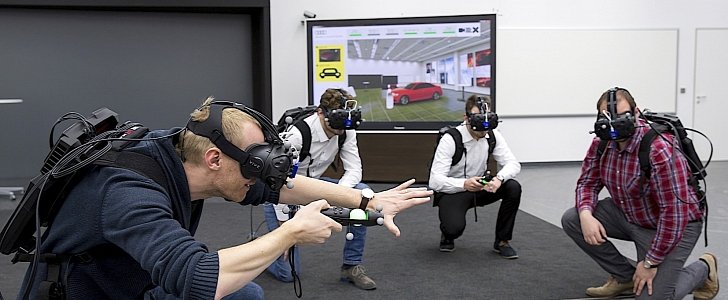At the end of January, we took a look at the way in which a self-proclaimed digital manufacturing company plans to use generative design, virtual reality, artificial intelligence, 3D printing, and a cloud-based supply chain to create any car dreamt of by its customers.
On Thursday, German carmaker Audi revealed that it too is working on a similar idea when it comes to its vehicles. Having already used virtual reality (VR) as a tool to develop 3D models of its futures cars, the Germans are now trying a more hand-on approach by testing a new technology, a VR holodeck.
The holodeck is a 225 square meters room (2,421 square feet) where Audi models are being projected and toyed with. Unlike a traditional VR model, seen on a computer screen, the holodeck allows Audi engineers to experience the car from both inside and outside. At any given time, six different people can occupy the room and tend about their business.
The holodeck trials, if successful, might one day replace the way in which car models are traditionally constructed prior to entering production. Currently, a car is being sent to the assembly line after both 2D computer graphics and expensive hand-made physical models have been built.
The holodeck system has been developed together with Stuttgart media agency Lightshape. Audi is dead serious on implementing the system into its production process by the year’s end.
Until then, the carmaker will have to train personnel to handle the VR holodeck equipment. This includes glasses, a 3 kg (6.6 pounds), a backpack containing a PC connected via Wi-Fi with a central workstation and two hand controllers.
“With the VR holodeck, we obtain a realistic impression of the proportions of our future models. This enables us to make important decisions faster,” said Martin Rademacher, the man in charge of the VR holodeck project.
The holodeck is a 225 square meters room (2,421 square feet) where Audi models are being projected and toyed with. Unlike a traditional VR model, seen on a computer screen, the holodeck allows Audi engineers to experience the car from both inside and outside. At any given time, six different people can occupy the room and tend about their business.
The holodeck trials, if successful, might one day replace the way in which car models are traditionally constructed prior to entering production. Currently, a car is being sent to the assembly line after both 2D computer graphics and expensive hand-made physical models have been built.
The holodeck system has been developed together with Stuttgart media agency Lightshape. Audi is dead serious on implementing the system into its production process by the year’s end.
Until then, the carmaker will have to train personnel to handle the VR holodeck equipment. This includes glasses, a 3 kg (6.6 pounds), a backpack containing a PC connected via Wi-Fi with a central workstation and two hand controllers.
“With the VR holodeck, we obtain a realistic impression of the proportions of our future models. This enables us to make important decisions faster,” said Martin Rademacher, the man in charge of the VR holodeck project.

















